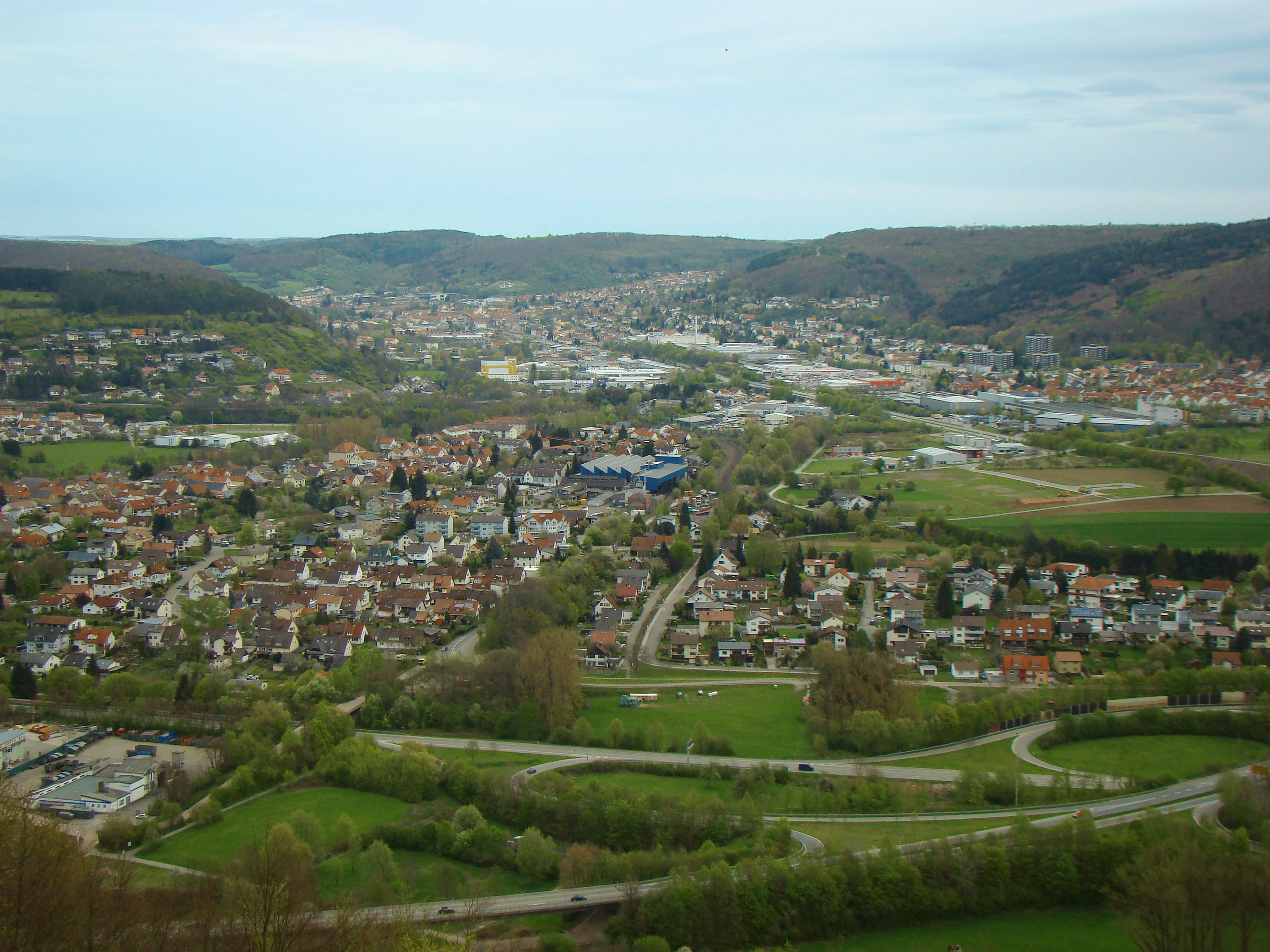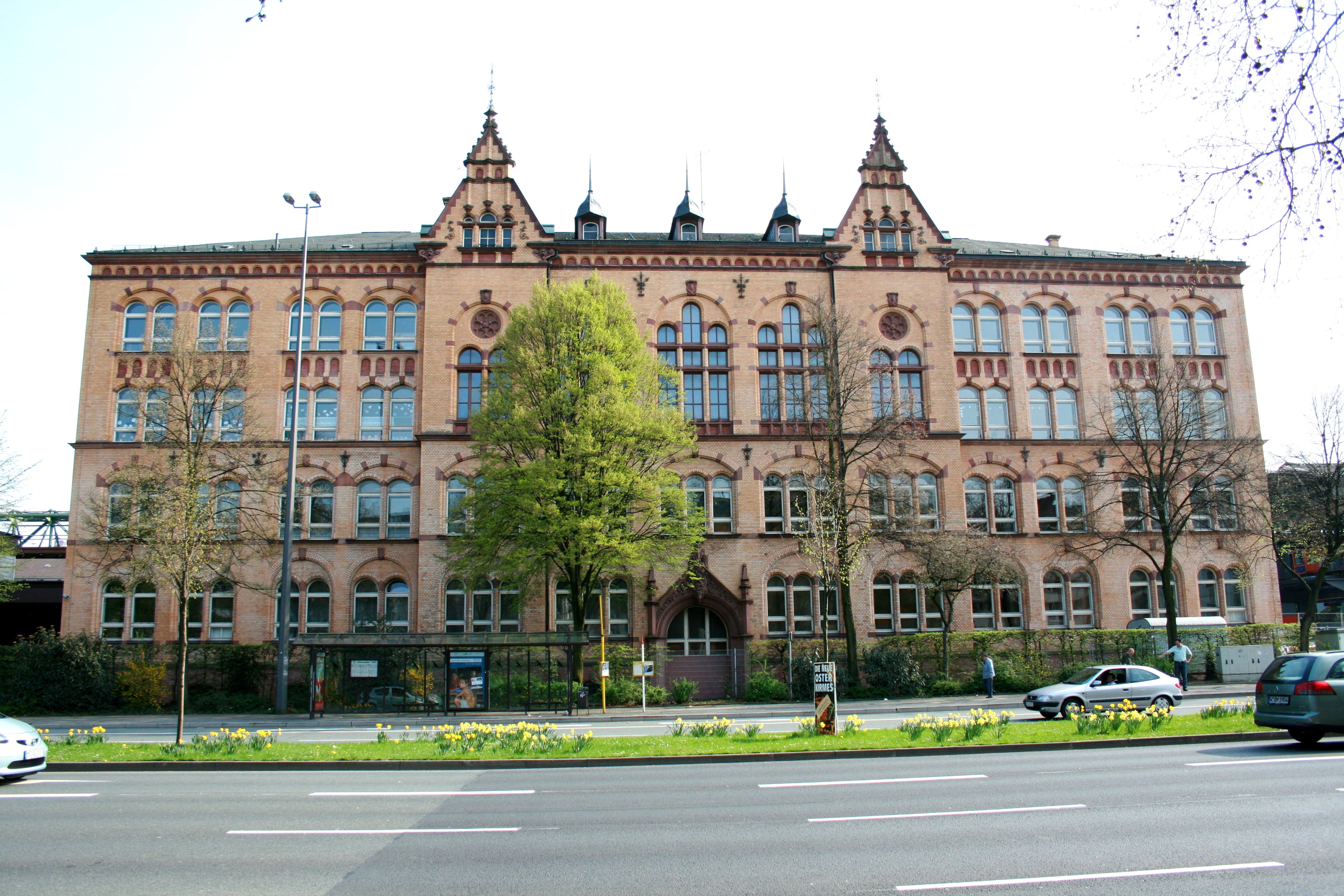|
Neckarelz
Neckarelz is a suburb of Mosbach in Baden-Württemberg, Germany. Geography Neckarelz is in northern Baden-Württemberg, between the Odenwald and Kraichgau, at the confluence of the Neckar and Elz rivers. On the other side of the Neckar, are the towns of Hochhausen and Obrigheim. Next to Neckarelz, is the suburb of Diedesheim. History The town was part of the Electorate of the Palatinate from around 1362. Religion Until World War II, Neckarelz was almost completely Protestant. After the arrival of Catholic refugees, a new church was built. Demographics Neckarelz is the largest suburb of Mosbach, with approximately 6,500 inhabitants. Coat of arms This depicts the rhombuses of the Electorate of the Palatinate at the top and a fish below. Education Neckarelz has several kindergartens, a primary school (named after Clemens Brentano), and a grammar and Hauptschule, (both named after Auguste Pattberg). Transport Neckarelz has a train station, connecting to the Neckar Valley R ... [...More Info...] [...Related Items...] OR: [Wikipedia] [Google] [Baidu] |
Neckarelz–Osterburken Railway
The Neckarelz–Osterburken railway is a 30.9 km long railway line in the north of the German state of Baden-Württemberg, which connects the Neckar and the Bauland along the edge of the Odenwald. It was opened in 1866 as part of the Odenwald Railway (Baden) (''Odenwaldbahn'') between Heidelberg and Würzburg. It has been upgraded to form an entirely double-track and electrified main line railway. It was an east–west axis for German long-distance transport until 1945. Since 2003 passenger services on it have been operated by the Rhine-Neckar S-Bahn. The Neckarelz–Mosbach section has also been served by the Heilbronn Stadtbahn since 2014. Route The track today starts at Mosbach-Neckarelz station, where the Neckar Valley Railway branches off. Until about 1960 there was a connecting curve from Mosbach to Hochhausen on the Neckar Valley Railway. Until 1895, the old route of the Odenwald Railway from Obrigheim connected before the line reaches the current site of the Mosb ... [...More Info...] [...Related Items...] OR: [Wikipedia] [Google] [Baidu] |
Neckar Valley Railway
The Neckar Valley Railway, or Neckar Valley Main Line (german: Neckartalbahn) is a railway line from Heidelberg via Eberbach and Mosbach to Bad Friedrichshall-Jagstfeld in southwestern Germany. Today it is administered by the Verkehrsverbund Rhein-Neckar (Rhine-Neckar Transport Authority) and is partly worked by the Rhine-Neckar S-Bahn. History The Heidelberg–Neckargemünd section of the line was built in 1862 as part of the Baden Odenwald Railway (''Baden Odenwaldbahn''), running from the Heidelberg via Neckargemünd, Meckenheim, Neckarbischofsheim, Aglasterhausen, Obrigheim, Neckarelz, Mosbach, Oberschefflenz, Seckach, Osterburken, Königshofen and Lauda to Würzburg. Construction of the line was authorised by a law of 27 April 1860. The Heidelberg–Neckargemünd section was opened on 23 October 1862. Although the most obvious option for the route between Neckargemünd and Neckarelz would have been to build the line along the Neckar, this would have meant running throu ... [...More Info...] [...Related Items...] OR: [Wikipedia] [Google] [Baidu] |
Neckar
The Neckar () is a river in Germany, mainly flowing through the southwestern state of Baden-Württemberg, with a short section through Hesse. The Neckar is a major right tributary of the Rhine. Rising in the Schwarzwald-Baar-Kreis near Schwenningen in the ''Schwenninger Moos'' conservation area at a height of above sea level, it passes through Rottweil, Rottenburg am Neckar, Kilchberg, Tübingen, Wernau, Nürtingen, Plochingen, Esslingen, Stuttgart, Ludwigsburg, Marbach, Heilbronn and Heidelberg, before discharging on average of water into the Rhine at Mannheim, at above sea level, making the Neckar its 4th largest tributary, and the 10th largest river in Germany. Since 1968, the Neckar has been navigable for cargo ships via 27 locks for about upstream from Mannheim to the river port of Plochingen, at the confluence with the Fils. From Plochingen to Stuttgart, the Neckar valley is densely populated and heavily industrialised, with several well-known companies. Between ... [...More Info...] [...Related Items...] OR: [Wikipedia] [Google] [Baidu] |
Odenwald
The Odenwald () is a low mountain range in the German states of Hesse, Bavaria and Baden-Württemberg. Location The Odenwald is located between the Upper Rhine Plain with the Bergstraße and the ''Hessisches Ried'' (the northeastern section of the Rhine rift) to the west, the Main and the Bauland (a mostly unwooded area with good soils) to the east, the Hanau-Seligenstadt Basin – a subbasin of the Upper Rhine Rift Valley in the Rhine-Main Lowlands – to the north and the Kraichgau to the south. The part south of the Neckar valley is sometimes called the ''Kleiner Odenwald'' ("Little Odenwald"). The northern and western Odenwald belong to southern Hesse, with the south stretching into Baden. In the northeast, a small part lies in Lower Franconia in Bavaria. Geology The Odenwald, along with other parts of the Central German Uplands, belongs to the Variscan, which more than 300 million years ago in the Carboniferous period ran through great parts of Europe. The cause ... [...More Info...] [...Related Items...] OR: [Wikipedia] [Google] [Baidu] |
Elz (Neckar)
The Elz () is a small river in Baden-Württemberg, Germany, a right tributary of the Neckar. It rises in the Odenwald. The Elz flows through Mudau, Limbach and Mosbach before reaching the Neckar in Neckarelz, a borough of Mosbach. Its length is 40 kilometres. Tributaries and Lakes (River length according to LUBW online map ) * Eisengraben, left tributary, 2.4km * Wasserrausch, left tributary, 2.3 km * Steinigsbächlein, left tributary, meets the Elz in (Mittel-)Langenelz, 0.9 km * Seeschlagbächlein, left tributary, 1.3 km * Einbach, left tributary, 2.6 km * unnamed creek, right tributary, 2.5 km * Landgraben, left tributary, 5.4 km * unnamed creek, right tributary, 2.4 km * Guckenbach, left tributary, meets the Elz in Rittersbach Elztal is a municipality in the Neckar-Odenwald district, in Baden-Württemberg, Germany. It is named after the valley of the river Elz. Geography The municipality Elztal is located in the southern part of t ... [...More Info...] [...Related Items...] OR: [Wikipedia] [Google] [Baidu] |
Obrigheim
Obrigheim ( South Franconian: ''Owweringe'') is a town in the district of Neckar-Odenwald-Kreis, in Baden-Württemberg, Germany. It is the location of the Obrigheim Nuclear Power Plant Obrigheim Nuclear Power Plant (KWO) is a mothballed nuclear power plant in Obrigheim, Neckar-Odenwald-Kreis, on the banks of the Neckar and owned by EnBW. It operated a pressurized water reactor unit from 1969 to 2005. It has been defuelled since .... History The concentration camp Neckarelz was from March 1944 to March 1945 an extension of the concentration camp Natzweiler-Struthof. Thousands of forced workers and KZ-prisoners had to build tunnels in the nearby mountains. Mayors In October 2014 Achim Walter (FDP) was elected the new mayor. He is the successor of Roland Lauer (CDU), he was 24 years in office. References Neckar-Odenwald-Kreis Populated places on the Neckar basin Populated riverside places in Germany {{NeckarOdenwald-geo-stub ... [...More Info...] [...Related Items...] OR: [Wikipedia] [Google] [Baidu] |
Mosbach
Mosbach (; South Franconian: ''Mossbach'') is a town in the north of Baden-Württemberg, Germany. It is the seat of the Neckar-Odenwald district and has a population of approximately 25,000 distributed in six boroughs: Mosbach Town, Lohrbach, Neckarelz, Diedesheim, Sattelbach and Reichenbuch. Geography Located about 35 km east of Heidelberg, it is situated south of the Odenwald mountains at a height of 134-354m at the confluence of the Neckar and the Elz. The town is part of the conservation area Naturpark Neckartal-Odenwald and the UNESCO ''Geopark Bergstraße-Odenwald''. History The settlement of Mosbach developed around the Benedictine monastery of Mosbach Abbey (''"Monasterium Mosabach"''), the first written record of which dates from the 9th century. In 1241 rights and privileges had been granted to Mosbach as an Imperial free city. These rights were lost in 1362 when Mosbach became part of the Electorate of the Palatinate. With the division of the lands of King Ru ... [...More Info...] [...Related Items...] OR: [Wikipedia] [Google] [Baidu] |
Catholic
The Catholic Church, also known as the Roman Catholic Church, is the largest Christian church, with 1.3 billion baptized Catholics worldwide . It is among the world's oldest and largest international institutions, and has played a prominent role in the history and development of Western civilization.O'Collins, p. v (preface). The church consists of 24 ''sui iuris'' churches, including the Latin Church and 23 Eastern Catholic Churches, which comprise almost 3,500 dioceses and eparchies located around the world. The pope, who is the bishop of Rome, is the chief pastor of the church. The bishopric of Rome, known as the Holy See, is the central governing authority of the church. The administrative body of the Holy See, the Roman Curia, has its principal offices in Vatican City, a small enclave of the Italian city of Rome, of which the pope is head of state. The core beliefs of Catholicism are found in the Nicene Creed. The Catholic Church teaches that it is th ... [...More Info...] [...Related Items...] OR: [Wikipedia] [Google] [Baidu] |
Auguste Pattberg
Auguste may refer to: People Surname * Arsène Auguste (born 1951), Haitian footballer * Donna Auguste (born 1958), African-American businesswoman * Georges Auguste (born 1933), Haitian painter * Henri Auguste (1759–1816), Parisian gold and silversmith * Joyce Auguste, Saint Lucian musician * Jules Robert Auguste (1789–1850), French painter * Tancrède Auguste (1856–1913), President of Haiti (1912–13) Given name * Auguste, Baron Lambermont (1819–1905), Belgian statesman * Auguste, Duke of Leuchtenberg (1810–1835), prince consort of Maria II of Portugal * Auguste, comte de La Ferronays (1777–1842), French Minister of Foreign Affairs * Auguste Clot (1858–1936), French art printer * Auguste Dick (1910–1993), Austrian historian of mathematics * Georges Auguste Escoffier (1846–1935), French chef, restaurateur and culinary writer * Auguste Metz (1812–1854), Luxembourgian entrepreneur * Auguste Léopold Protet (1808–1862), French Navy admiral * Auguste Picc ... [...More Info...] [...Related Items...] OR: [Wikipedia] [Google] [Baidu] |
Hauptschule
A ''Hauptschule'' (, "general school") is a secondary school in Germany, starting after four years of elementary schooling (''Grundschule''), which offers Lower Secondary Education (Level 2) according to the International Standard Classification of Education. Any student who attends a German elementary school can go to a ''Hauptschule'' or ''Gesamtschule'', while students who want to attend a ''Realschule'' or '' Gymnasium'' need to have good marks in order to do so. The students spend five to six years at the ''Hauptschule'', from 5th to 9th (or 10th) grade. They finish around age 15 to 17. History ''Hauptschulen'' (plural for Hauptschule) were first introduced in West Germany in 1950 and are now a part of secondary education in Germany, the other schools being the '' Gymnasium'' for the university-bound and the ''Realschule'' for the future technicians. Basics The main aim of ''Hauptschulen'' is to offer young students with average grades or below, most of whom will not attend ... [...More Info...] [...Related Items...] OR: [Wikipedia] [Google] [Baidu] |
Clemens Brentano
Clemens Wenzeslaus Brentano (also Klemens; pseudonym: Clemens Maria Brentano ; ; 9 September 1778 – 28 July 1842) was a German poet and novelist, and a major figure of German Romanticism. He was the uncle, via his brother Christian, of Franz and Lujo Brentano. Biography Clemens Brentano was born to Peter Anton Brentano and Maximiliane von La Roche, a wealthy merchant family in Frankfurt on 9 September 1778. His father's family was of Italian descent. His maternal grandmother was Sophie von La Roche. His sister was writer Bettina von Arnim, who, at a young age, lionised and corresponded with Goethe, and, in 1835, published the correspondence as ''Goethes Briefwechsel mit einem Kinde'' (Goethe's correspondence with a child). Clemens Brentano studied in Halle and Jena, afterwards residing at Heidelberg, Vienna and Berlin. He was close to Wieland, Herder, Goethe, Friedrich Schlegel, Fichte and Ludwig Tieck, Tieck. From 1798 to 1800 Brentano lived in Jena, the first center of t ... [...More Info...] [...Related Items...] OR: [Wikipedia] [Google] [Baidu] |





.jpg)

